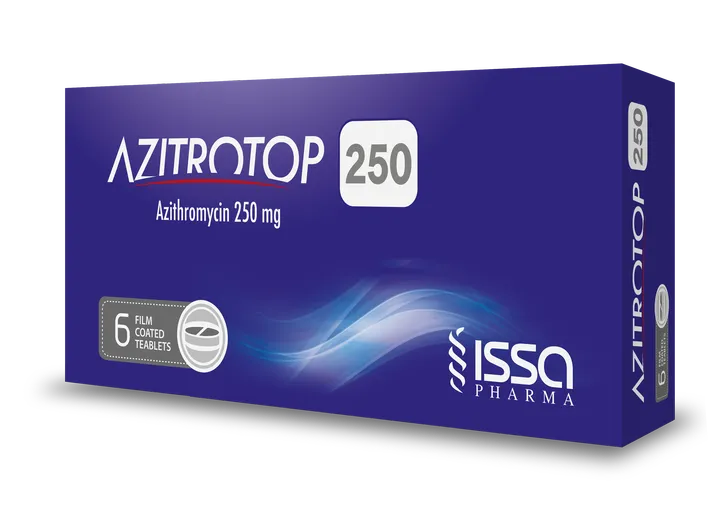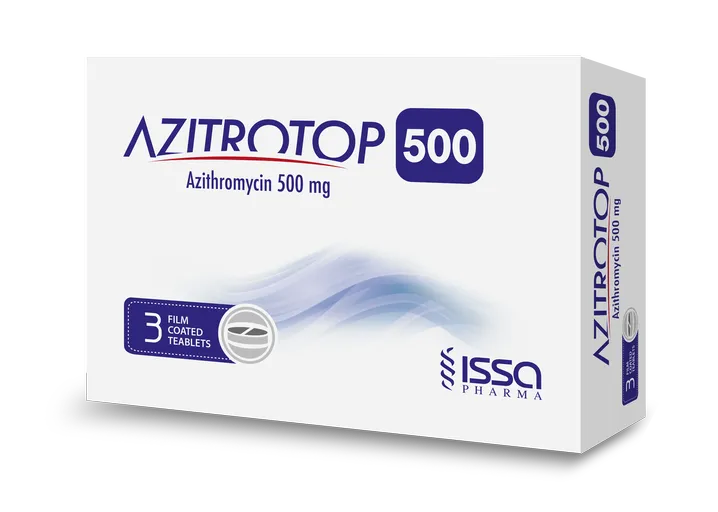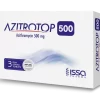COMPOSITION AND EXCIPIENTS
Active ingredient:
-
Each film coated tablet of Azitrotop 250 contains Azithromycin 250 mg (as Azithromycin dihydrate).
-
Each film coated tablet of Azitrotop 500 contains Azithromycin 500 mg (as Azithromycin dihydrate).
Excipients:
-
Azitrotop 250 , 500 film coated tablets: Pregelatinsed starch, Calcium hydrogen phosphate, Croscarmellose Sodium, Magnesium stearate, Sodium lauryl sulfate, Lactose, Hypromellose, Titanium dioxide, Glycerol triacetate.
MECHANISM OF ACTION
Azithromycin is a macrolide antibiotic belonging to the azalide group. The mechanism of action of azithromycin is based upon the suppression of bacterial protein synthesis by means of binding to the ribosomal 50s sub-unit and inhibition of peptide translocation.
Commonly susceptible species:
Aerobic Gram-positive microorganisms:
Staphylococcus aureus Methycillin-susceptible.
Streptococcus pneumoniae Penicillin-susceptible.
Streptococcus pyogenes (Group A).
Aerobic Gram-negative microorganisms:
Haemophilus influenza, Haemophilus parainfluenzae, Legionella pneumophila, Moraxella catarrhalis,
Neisseria gonorrhoeae, Pasteurella multocida.
Anaerobic microorganisms:
Clostridium perfringens, Fusobacterium spp, Prevotella spp, Porphyromonas spp.
Other microorganisms:
Chlamydia trachomatis.
PHARMACOKINETIC PROPERTIES
Absorption:
Bioavailability after oral administration is approximately 37%. Peak plasma concentrations are attained 2-3 hours after taking the product.
Distribution:
Orally administered azithromycin is widely distributed throughout the body. In pharmacokinetic studies it has been demonstrated that the concentrations of azithromycin measured in tissues are noticeably higher (as much as 50 times) than those measured in plasma, which indicates that the agent strongly binds to tissues.
Binding to serum proteins varies according to plasma concentration and ranges from 12% at 0.5 microgram/ml up to 52% at 0.05 microgram azithromycin/ml serum. The mean volume of distribution at steady state (VVss) has been calculated to be 31.1 l/kg.
Elimination:
The terminal plasma elimination half-life closely reflects the elimination half-life from tissues of 2-4 days.
Approximately 12% of an intravenously administered dose of azithromycin is excreted unchanged in urine within the following three days. Particularly high concentrations of unchanged azithromycin have been found in human bile. Also in bile, ten metabolites were detected.
INDICATIONS
Adult Patients:
-
Acute bacterial exacerbations of chronic bronchitis.
-
Acute bacterial sinusitis.
-
Community-acquired pneumonia.
-
Pharyngitis/tonsillitis.
-
Uncomplicated skin and skin structure infections.
-
Urethritis and cervicitis.
-
Genital ulcer disease in men due to Haemophilus ducreyi (chancroid).
Pediatric Patients:
-
Acute otitis media (>6 months of age) caused by Haemophilus influenzae, Moraxella catarrhalis, or Streptococcus pneumoniae.
-
Community-acquired pneumonia (>6 months of age) due to Chlamydophila pneumoniae, Haemophilus influenzae, Mycoplasma pneumoniae, or Streptococcus pneumoniae in patients appropriate for oral therapy.
-
Pharyngitis/tonsillitis (>2 years of age ) caused by Streptococcus pyogenes as an alternative to first line therapy in individuals who cannot use first-line therapy.
Limitations of Use:
Azithromycin should not be used in patients with pneumonia who are judged to be inappropriate for oral therapy because of moderate to severe illness or risk factors such as any of the following:
-
patients with cystic fibrosis.
-
patients with nosocomial infections.
-
patients with known or suspected bacteremia.
-
patients requiring hospitalization.
-
elderly or debilitated patients, or
-
patients with significant underlying health problems that may compromise their ability to respond to their illness (including immunodeficiency or functional asplenia).
CONTRAINDICATIONS
Azithromycin is contra-indicated in patients with a known hypersensitivity to azithromycin or any of the macrolide or ketolide antibiotics, erythromycin, or to any excipients.
WARNINGS AND PRECAUTIONS
Hypersensitivity:
As with erythromycin and other macrolides, rare serious allergic reactions including angioneuroticoedema and anaphylaxis (rarely fatal), have been reported. Some of these reactions with azithromycin have resulted in recurrent symptoms and required a longer period of observation and treatment.
Hepatotoxicity:
Since the liver is the principal route of elimination for azithromycin, the use of azithromycin should be undertaken with caution in patients with significant hepatic disease. Cases of fulminant hepatitis potentially leading to life-threatening liver failure have been reported with azithromycin. Some patients may have had pre-existing hepatic disease or may have been taking other hepatotoxic medicinal products.
In case of signs and symptoms of liver dysfunction, such as rapid developing asthenia associated with jaundice, dark urine, bleeding tendency or hepatic encephalopathy, liver function tests/ investigations should be performed immediately. Azithromycin administration should be stopped if liver dysfunction has emerged.
Ergot derivatives:
In patients receiving ergot derivatives, ergotism has been precipitated by co-administration of some macrolide antibiotics. There are no data concerning the possibility of an interaction between ergot and azithromycin. However, because of the theoretical possibility of ergotism, azithromycin and ergot derivatives should not be co-administrated.
Prolongation of the QT interval:
Prolonged cardiac repolarisation and QT interval, imparting a risk of developing cardiac arrhythmia and torsades de pointes, have been seen in treatment with other macrolides. A similar effect with azithromycin cannot be completely ruled out in patients at increased risk for prolonged cardiac repolarisation ; therefore caution is required when treating patients:
• With congenital or documented QT prolongation.
• Currently receiving treatment with other active substance known to prolong QT interval such as antiarrhytmics of classes Ia and III, cisapride and terfenadine.
• With electrolyte disturbance, particularly in case of hypokalaemia and hypomagnesemia.
• With clinically relevant bradycardia, cardiac arrhythmia or severe cardiac insufficiency.
Superinfection:
As with any antibiotic preparation, observation for signs of superinfection with non-susceptible organisms including fungi is recommended.
Clostridium difficile associated diarrhea:
Clostridium difficile associated diarrhoea (CDAD) has been reported with use of nearly all antibacterial agents, including azithromycin, and may range in severity from mild diarrhoea to fatal colitis. Strains of C. difficile producing hypertoxin A and B contribute to the development of CDAD. Hypertoxin producing strains of C. difficile cause increased morbidity and mortality, as these infections can be refractory to antimicrobial therapy and may require colectomy. Therefore, CDAD must be considered in patients who present with diarrhoea during or subsequent to the administration of any antibiotics. Careful medical history is necessary since CDAD has been reported to occur over two months after the administration of antibacterial agents. Discontinuation of therapy with azithromycin and the administration of specific treatment for C. difficile should be considered.
Streptococcal infections:
Penicillin is usually the first choice for treatment of pharyngitis/tonsillitis due to Streptococcus pyogenes and also for prophylaxis of acute rheumatic fever. Azithromycin is in general effective against streptococcus in the oropharynx, but no data are available that demonstrate the efficacy of azithromycin in preventing acute rheumatic fever.
Renal impairment:
In patients with severe renal impairment (GFR <10 ml/min) a 33% increase in systemic exposure to azithromycin was observed.
Myasthenia gravis:
Exacerbations of the symptoms of myasthenia gravis and new onset of myasthenia syndrome have been reported in patients receiving azithromycin therapy.
DRUG INTERACTIONS
Antacids: In a pharmacokinetic study investigating the effects of simultaneous administration of antacid with azithromycin, no effect on overall bioavailability was seen, although peak serum concentrations were reduced by approximately 24%. In patients receiving both azithromycin and antacids, the drugs should not be taken simultaneously.
Digoxin: Some of the macrolide antibiotics have been reported to impair the microbial metabolism of digoxin in the gut in some patients. In patients receiving concomitant azithromycin and digoxin the possibility of raised digoxin levels should be borne in mind.
Zidovudine: Administration of azithromycin increased the concentrations of phosphorylated zidovudine, the clinically active metabolite, in peripheral blood mononuclear cells.
Ergot derivatives: Due to the theoretical possibility of ergotism, the concurrent use of azithromycin with ergot derivatives is not recommended.
Coumarin-Type Oral Anticoagulants: Although a causal relationship has not been established, consideration should be given to the frequency of monitoring prothrombin time when azithromycin is used in patients receiving coumarin-type oral anticoagulants.
Ciclosporin: If co-administration of these drugs is necessary, ciclosporin levels should be monitored and the dose adjusted accordingly.
PREGNANCY:
There are no adequate and well-controlled studies in pregnant women. therefore azithromycin should be used during pregnancy only if clearly needed.
BREAST-FEEDING:
Azithromycin should not be used in the treatment of a lactating woman unless the potential benefits justify the potential risks to the infant.
SIDE EFFECTS
Candidiasis, oral candidiasis, vaginal infection, leukopenia, neutropenia, angioedema, hypersensitivity, anorexia, nervousness, dizziness, headache, paraesthesia, dysgeusia, hypoaesethesia, somnolence, insomnia ,visual impairment, deafness, hearing impaired, tinnitus, palpitations, diarrhoea, abdominal pain, nausea, flatulence, vomiting, dyspepsia, gastritis, constipation, hepatitis, pruritus, rash, Stevens-Johnson syndrome, photosensitivity reaction, urticaria, arthralgia, fatigue, chest pain, oedema, malaise, asthenia, lymphocyte count decreased, eosinophil count increased, blood bicarbonate decreased, aspartate aminotransferase increased, alanine aminotransferase increased, blood bilirubin increased, blood urea increased, blood creatinine increased, blood potassium abnormal.
DOSAGE AND ADMINISTRATION
Adult Patients:
|
Infection |
Recommended Dose/ Duration of Therapy |
|
Community-acquired pneumonia (mild severity) |
500 mg as a single dose on Day 1, followed by 250 mg once daily on Days 2 through 5. |
|
Acute bacterial exacerbations of chronic bronchitis (mild to moderate) |
500 mg as a single dose on Day 1, followed by 250 mg once daily on Days 2 through 5 or 500 mg once daily for 3 days. |
|
Acute bacterial sinusitis |
500 mg once daily for 3 days. |
|
Genital ulcer disease (chancroid) |
One single 1 gram dose. |
|
Gonococcal urethritis and cervicitis |
One single 2 gram dose. |
Pediatric Patients:
|
Infection |
Recommended Dose/ Duration of Therapy |
|
Acute otitis media |
30 mg/kg as a single dose or 10 mg/kg once daily for 3 days or 10 mg/kg as a single dose on Day 1 followed by 5 mg/kg/day on Days 2 through 5. |
|
Acute bacterial sinusitis |
10 mg/kg once daily for 3 days. |
|
Community-acquired pneumonia |
10 mg/kg as a single dose on Day 1 followed by 5 mg/kg once daily on Days 2 through 5. |
|
Pharyngitis / tonsillitis |
12 mg/kg once daily for 5 days. |
Pediatric dosage guidelines for otitis media and community-acquired pneumonia (Age 6 months and above):
|
Weight |
100 mg/5 ml |
200 mg/5 ml |
Total ml per Treatment Course |
Total mg per Treatment Course |
|||
|
Kg |
Lbs. |
Day 1 |
Days 2–5 |
Day 1 |
Days 2–5 |
||
|
5 |
11 |
2.5 ml (½ tsp) |
1.25 ml (¼ tsp) |
7.5 ml |
150 mg |
||
|
10 |
22 |
5 ml (1tsp) |
2.5 ml (½ tsp) |
15 ml |
300 mg |
||
|
20 |
44 |
5 ml (1 tsp) |
2.5 ml (½ tsp) |
15 ml |
600 mg |
||
|
30 |
66 |
7.5 ml (1½ tsp) |
3.75 ml (¾ tsp) |
22.5 ml |
900 mg |
||
|
40 |
88 |
10 ml (2 tsp) |
5 ml (1 tsp) |
30 ml |
1200 mg |
||
|
50 and above |
110 and above |
12.5 ml (2½ tsp) |
6.25 ml (1¼ tsp) |
37.5 ml |
1500 mg |
||
Otitis media and acute bacterial sinusitis (3-Day Regimen):
|
Weight |
100 mg/5 ml |
200 mg/5 ml |
Total ml per Treatment Course |
Total mg per Treatment Course |
|
|
Kg |
Lbs. |
Days 1-3 |
Days 1–3 |
||
|
5 |
11 |
2.5 ml (1/2 tsp) |
7.5 ml |
150 mg |
|
|
10 |
22 |
5 ml (1 tsp) |
15 ml |
300 mg |
|
|
20 |
44 |
5 ml (1 tsp) |
15 ml |
600 mg |
|
|
30 |
66 |
7.5 ml (1½ tsp) |
22.5 ml |
900 mg |
|
|
40 |
88 |
10 ml (2 tsp) |
30 ml |
1200 mg |
|
|
50 and above |
110 and above |
12.5 ml (2½ tsp) |
37.5 ml |
1500 mg |
|
Otitis media (1-Day Regimen):
|
Weight |
200 mg/5 ml |
Total ml per Treatment Course |
Total mg per Treatment Course |
|
|
Kg |
Lbs. |
1-Day Regimen |
||
|
5 |
11 |
3.75 ml (3/4 tsp) |
3.75 ml |
150 mg |
|
10 |
22 |
7.5 ml (1½ tsp) |
7.5 ml |
300 mg |
|
20 |
44 |
15 ml (3 tsp) |
15 ml |
600 mg |
|
30 |
66 |
22.5 ml (4½ tsp) |
22.5 ml |
900 mg |
|
40 |
88 |
30 ml (6 tsp) |
30 ml |
1200 mg |
|
50 and above |
110 and above |
37.5 ml (7½ tsp) |
37.5 ml |
1500 mg |
Pediatric dosage guidelines for pharyngitis/tonsillitis (Age 2 years and above):
|
Weight |
200 mg/5 ml |
Total ml per Treatment Course |
Total mg per Treatment Course |
|
|
Kg |
Lbs. |
Day 1–5 |
||
|
8 |
18 |
2.5 ml (½ tsp) |
12.5 ml |
500 mg |
|
17 |
37 |
5 ml (1 tsp) |
25 ml |
1000 mg |
|
25 |
55 |
7.5 ml (1½ tsp) |
37.5 ml |
1500 mg |
|
33 |
73 |
10 ml (2 tsp) |
50 ml |
2000 mg |
|
40 |
88 |
12.5 ml (2½ tsp) |
62.5 ml |
2500 mg |
Instructions of reconstitution: The table below indicates the volume of water to be used for constitution:
|
Amount of water to be added |
Total volume after constitution (Azithromycin content) |
Azithromycin concentration after constitution |
|
8 ml (300 mg) |
15 ml (300 mg) |
100 mg/5 ml |
|
8 ml (600 mg) |
15 ml (600 mg) |
200 mg/5 ml |
|
16 ml (1200 mg) |
30 ml (1200 mg) |
200 mg/5 ml |
OVERDOSE
Adverse events experienced in higher than recommended doses were similar to those seen at normal doses. The typical symptoms of an overdose with macrolide antibiotics include reversible loss of hearing, severe nausea, vomiting and diarrhoea. In the event of overdose, the administration of medicinal charcoal and general symptomatic treatment and supportive measures are indicated as required.
STORAGE CONDITIONS
-
Store in a dry place, at temperature below 30°C, in the original packaging.
PACKAGING
-
Azitrotop 250 film coated tablets: Carton pack contains 6 tablets and enclosed leaflet.
-
Azitrotop 500 film coated tablets: Carton pack contains 3 tablets and enclosed leaflet.



